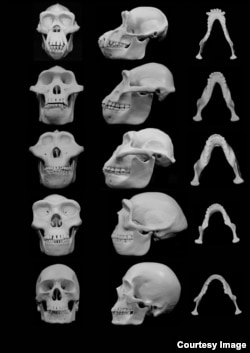WASHINGTON —
The human face evolved so that it could take a punch, researchers suggest in a new study.
It's a much more violent explanation than the leading alternative, that our skulls changed to accommodate a diet of hard-to-chew foods. And the authors said it suggests a pugilistic past where violence was key to our evolution.
When people fight, they go for the face, said study co-author Mike Morgan.
Morgan knows a little something about fights. He is a black belt in two martial arts and is training as an emergency medicine physician at the University of Utah.
"It gives me first-hand experience with a lot of the end results of human violence and aggression," he said.
Strong jaw
In the new study in the journal Biological Reviews, Morgan and his University of Utah co-author, David Carrier, noted that over the past 4 million years, our hominid ancestors evolved thicker and less protruding jaws, stronger jaw muscles and teeth, and a reinforced bone under the eye socket -- all areas that take a beating in a fight.
Last year, the authors published a paper detailing how the fist evolved over that time to be a better fighting weapon.
Only humans fight with fists. Dogs bite. Cats scratch. Antelopes gore. Our closest primate relatives, the chimpanzees, can't form fists. They slap.
Morgan said a punch hurts more than a slap because it delivers force to a smaller area.
"If you have a better weapon, you can theoretically win more mates," which means more chances to pass on your genes, which is what evolution is all about, he said.
Better defenses
And as the weapon got better, Morgan's research proposed, so did the defense.
"As we developed this ability to form a fist, we see an equal development in the robusticity and strength of the most commonly struck portions of the face," Morgan said.
All this suggests an extremely violent human evolutionary history.
"At one point in time, it made sense for us to be aggressive and violent," Morgan said. "It guaranteed the survival of our species."
Brains may have won out over brawn in the evolution of the modern human species.
The researchers note that our skulls are weaker in some of the same key areas compared to earlier ancestral species - changes that coincide with a decline in upper-body strength and a less powerful punch.
Skeptics
However, the fist-evolution study did not convince critics, who noted that fists are good for gripping tools and other uses besides fighting. Morgan expects a vigorous debate over his latest study, too.
"This is certainly a creative new idea," said George Washington University anthropologist Brian Richmond, "but there is abundant evidence to support the hypothesis that changes in diet and food processing best explain the decrease in the size of the face during human evolution."
Morgan promised the fight over the competing theories will end peacefully.
It's a much more violent explanation than the leading alternative, that our skulls changed to accommodate a diet of hard-to-chew foods. And the authors said it suggests a pugilistic past where violence was key to our evolution.
When people fight, they go for the face, said study co-author Mike Morgan.
Morgan knows a little something about fights. He is a black belt in two martial arts and is training as an emergency medicine physician at the University of Utah.
"It gives me first-hand experience with a lot of the end results of human violence and aggression," he said.
Strong jaw
In the new study in the journal Biological Reviews, Morgan and his University of Utah co-author, David Carrier, noted that over the past 4 million years, our hominid ancestors evolved thicker and less protruding jaws, stronger jaw muscles and teeth, and a reinforced bone under the eye socket -- all areas that take a beating in a fight.
Last year, the authors published a paper detailing how the fist evolved over that time to be a better fighting weapon.
Only humans fight with fists. Dogs bite. Cats scratch. Antelopes gore. Our closest primate relatives, the chimpanzees, can't form fists. They slap.
Morgan said a punch hurts more than a slap because it delivers force to a smaller area.
"If you have a better weapon, you can theoretically win more mates," which means more chances to pass on your genes, which is what evolution is all about, he said.
Better defenses
And as the weapon got better, Morgan's research proposed, so did the defense.
"As we developed this ability to form a fist, we see an equal development in the robusticity and strength of the most commonly struck portions of the face," Morgan said.
All this suggests an extremely violent human evolutionary history.
"At one point in time, it made sense for us to be aggressive and violent," Morgan said. "It guaranteed the survival of our species."
Brains may have won out over brawn in the evolution of the modern human species.
The researchers note that our skulls are weaker in some of the same key areas compared to earlier ancestral species - changes that coincide with a decline in upper-body strength and a less powerful punch.
Skeptics
However, the fist-evolution study did not convince critics, who noted that fists are good for gripping tools and other uses besides fighting. Morgan expects a vigorous debate over his latest study, too.
"This is certainly a creative new idea," said George Washington University anthropologist Brian Richmond, "but there is abundant evidence to support the hypothesis that changes in diet and food processing best explain the decrease in the size of the face during human evolution."
Morgan promised the fight over the competing theories will end peacefully.









